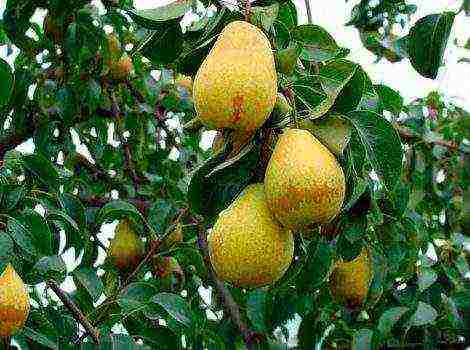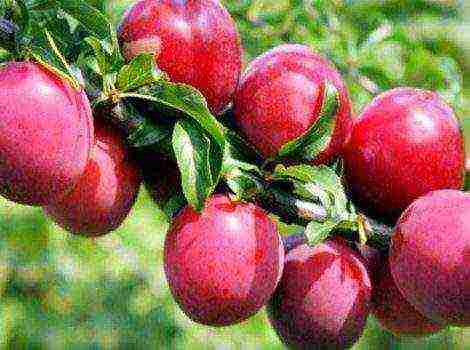Content
Top best varieties of cherries for the Moscow region
For a long time, sweet cherry was considered a traditionally southern culture, which significantly limited the geography of its cultivation.
The breeding by breeders of relatively adapted to the harsh natural conditions for culture made it possible to grow cherries in the gardens of the Moscow region. This article provides a detailed overview of the best cherry varieties for the Moscow region, including self-fertile and columnar species.
Popular varieties of cherries for the Moscow region
Sweet cherry is less winter-hardy and more thermophilic than other members of the Plum family. Therefore, the basis for its successful cultivation is the correct choice of the variety. Popular among gardeners of the Moscow region are varieties that have proven their positive characteristics over the entire period of cultivation.
Narodnaya Syubarova
This type of sweet cherry has good performance in the Moscow region. Differs in high acclimatization, plasticity to climatic and soil conditions of the region.
It is a tall tree with a powerful trunk and strong branches that can withstand the heavy load of winter precipitation and squally winds. The average yield is 35-50 kg, it is stable for many years. Fruiting in the second decade of July. Fruits are dark red with an average weight of 4.6 g.
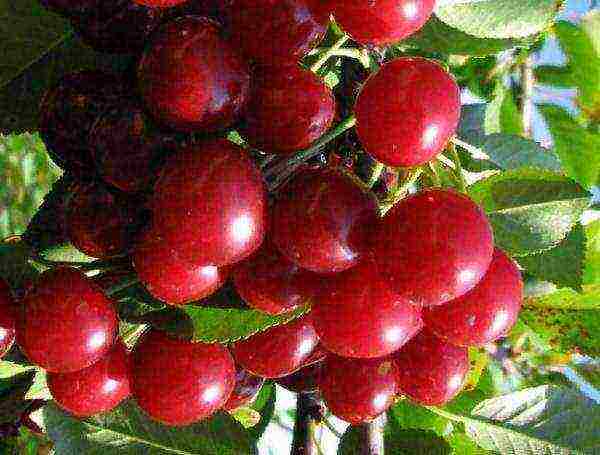
Iput
Gardeners love this type of sweet cherry for the commercial attractiveness of cultivation, which is provided by the ratio of stability and volume of fruiting. The peculiarities of this cherry variety are resistance to fungal diseases and winter hardiness, which greatly facilitates the care of the tree.
This is a medium-sized tree with a wide-pyramidal crown. Early ripening of fruits - June 15. Fruit weight up to 9 g, dark red color, almost black when fully ripe. Productivity 30 kg.

Ovstuzhenka
The popularity of this species is based on the special quality of the fruit, high yield and the compactness of the crown, which makes it possible to grow cherries in limited areas. In addition, sweet cherry fruits are distinguished by good transportability and pleasant taste.
The frost resistance of the tree is up to -31 °, the winter resistance is good. Early ripening of fruits - June 20. Productivity from 16 to 30 kg. The color of the fruits is red, the flesh is juicy and dense, weight is 4-7 g. The tree is resistant to moniliosis and coccomycosis.
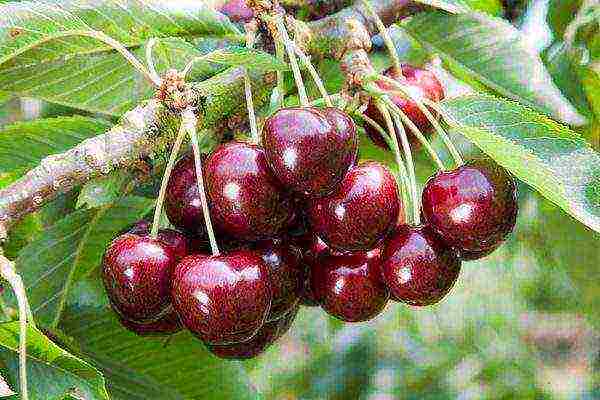
Fatezh
This cherry owes its popularity to its high yield. With a combination of favorable factors, up to 50 kg of fruits can be harvested from one tree. The appearance of the fruit is also different, on a red background you can see yellow spots on the sides. Fruits are sweet with low acidity with an average weight of 4.2 g.
It is a medium-sized tree with a spherical and drooping crown. The level of winter hardiness is above average, disease resistance is good.
The popularity of these species in the Moscow region is based on adaptation to regional climatic conditions, plasticity to the peculiarities of the winter season, and quick acclimatization.
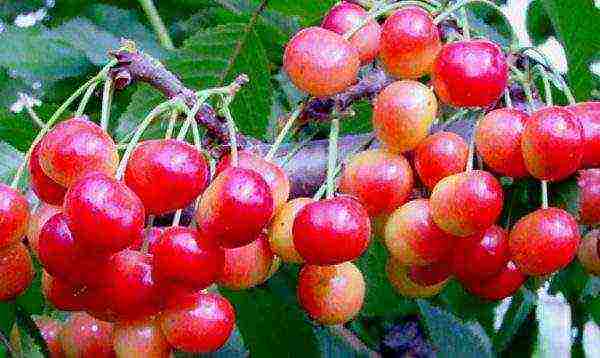
Growing winter-hardy varieties
Winter hardiness of a tree is the ability to withstand the adverse conditions of the winter season. These are the effects of thaw, soaking, ice crust and damping. The winter hardiness of a certain sweet cherry is due to the individual organization of the body and adaptation to living conditions in winter conditions with a slowed metabolism and dehydration.
To assess the winter hardiness of fruit trees, a seven-point scale is used, where trees with 6-7 points are classified as winter-hardy.
The climatic features of the Moscow region have undergone some changes since the middle of the last century. Winter comes later, temperatures are lower than average, and there are frequent thaws. This is due not only to natural disasters, but also to the activities of the metropolis. In general, conditions for growing sweet cherries are favorable.
Varieties with good winter hardiness:
- Fatezh,
- Valery Chkalov,
- Raditsa;
- Ovstuzhenka;
- Chermashnaya;
- Victory;
- Bryansk pink;
- Tyutchevka;
- Jealous;
- Narodnaya Syubarova.
After studying the economic and biological characteristics, the best winter hardiness indicators were noted in the varieties "Fatezh" and "Chermashnaya". In terms of early maturity, quality and volume of the harvest, Pobeda turned out to be the best.
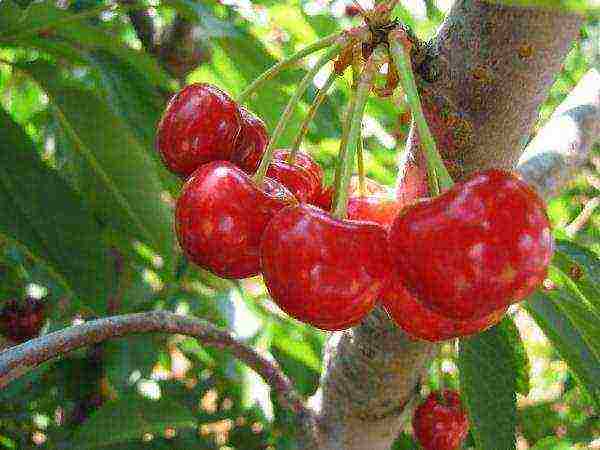
Review and planting of cherry varieties by ripening dates
When laying an orchard or picking up a new tree to be adjacent to existing crops, it is important to pay attention to the timing of fruit ripening. This will help to increase the period of consumption of the fresh crop and rationally distribute the flow of fruits for storage or harvesting.
Early
Cherry ripens in the third decade of June.
Main varieties:
- Raditsa,
- Ariadne,
- Iput,
- Gronkavaya,
- Homeland,
- Early pink.
The earliest fruit ripening is the Iput variety - June 15th. In addition, this variety has the best indicators in terms of crop volume, the average indicator is 30 kg. Also, the variety is distinguished by high rates of winter hardiness and resistance to fungal diseases. The most delicious and high-quality fruits are found in the Rodina variety, almost similar to the southern varieties.
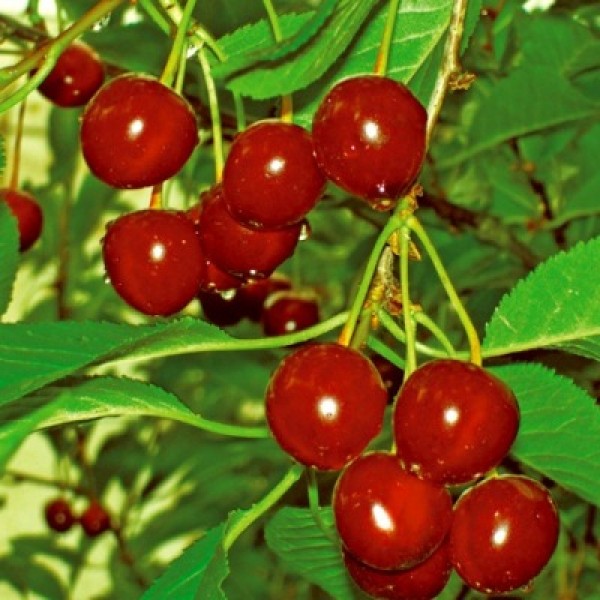
Growing mid-season varieties
Fruit ripening in the Moscow region begins in mid-July.
Recommended varieties:
- Jealous,
- Fatezh,
- Ovstuzhenka,
- Veda,
- Raditsa,
- Oryol pink,
- Tyutchevka,
- Rechitsa.
These types of cherries have passed practical tests in the climatic and soil conditions of the Moscow region. The varieties "Fatezh", "Revna", "Tyutchevka", "Ovstuzhenka" have the best winter hardiness. Variety "Raditsa" has a compact crown and is convenient for growing in small areas.
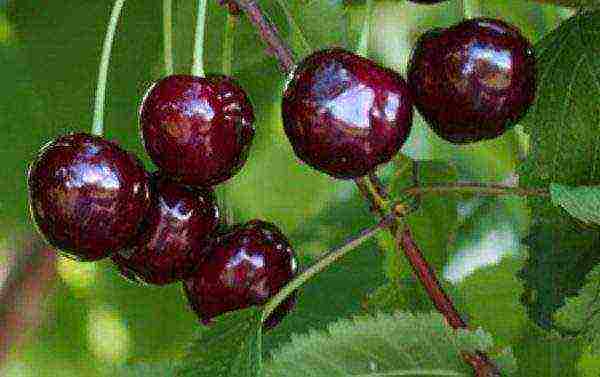
Late ripening varieties harvested in autumn
The fruits ripen in early August.
Main types:
- Bryansk pink,
- Red dense
- Leningrad black.
The best features are Bryanskaya Rosovaya, which was tested in Michurinsky Garden. He has proven resistance to fungal diseases, winter hardiness and frost resistance. Productivity is 20-30 kg, fruit quality is high.

Good types of cherries with yellow fruits
The red shades of cherry fruits are attractive to birds, especially to mountain ash thrushes, which can destroy the entire crop in a few hours.Cherries of early ripening most often suffer from damage, so it is recommended to cover them with a net. The yellow color of the fruit does not attract birds, and the harvest is completely preserved.
In addition, with heavy and prolonged rains, red fruits crack and lose their commercial quality. Yellow fruits have a more plastic shell, so they are slightly damaged.
Main varieties:
- Backyard yellow,
- Chermashnaya,
- Drogana yellow
- Red dense.
The Drogana yellow variety is distinguished by the highest adaptability to the climatic conditions of the Moscow region. It is the most productive variety in this category and has been stable for 25 years.
In terms of winter hardiness, the Chermashnoy variety has the best indicators. The rest of the varieties have an average winter hardiness and require more thorough preparation for the winter period.
Disadvantages of sweet cherries with yellow fruits: low transportability, frequent damage by cherry fly.
The laying of an orchard is always accompanied by a painful choice of varieties or a particular culture. The cultivation of sweet cherry compares favorably with crops close to it in high yield and resistance to many diseases.
Despite the appearance of zoned species, the life span and health of the fruit tree depends entirely on the gardener. And you need to lay the foundation for this already when choosing a variety.
And at the end, a short video on how to plant cherries, as well as take care of the tree in spring and autumn:
